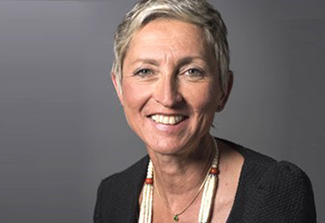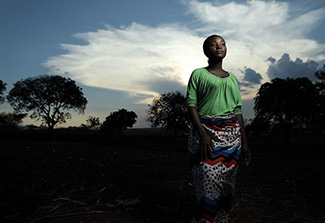Failing less by listening more: How to create sustainable teen HIV care
May / June 2022 | Volume 21 Number 3
 Photo courtesy of International AIDS Society
Dr. Linda-Gail Bekker, former Fogarty trainee, addressed the annual meeting of AHISA.
Photo courtesy of International AIDS Society
Dr. Linda-Gail Bekker, former Fogarty trainee, addressed the annual meeting of AHISA.
Tasting independence for the first time, many adolescents do not seek out medical services—even when urgent reproductive health issues emerge. How, then, do health professionals reach them? “Adolescent-friendly approaches are needed,” said Dr. Linda-Gail Bekker at Fogarty’s sixth annual meeting of the
Adolescent HIV Prevention and Treatment Implementation Science Alliance (AHISA) in March. “Adolescent-friendly” means tailored services with flexibility around timing and accessibility provided alongside relevant, confidential information, explained Bekker, Director of the Desmond Tutu HIV Centre at the University of Cape Town. “And where possible there are comprehensive services integrated into the mix and, when referrals are needed, they come with navigation assistance, preferably peer navigation.”
AHISA, a Fogarty-led alliance, comprises 26 teams of NIH‐funded researchers, program implementers and policymakers working in 11 countries in sub-Saharan Africa. AHISA aims to enhance the effective use of evidence to help overcome implementation challenges related to caring for adolescents with HIV in Africa. Bekker believes HIV services should never hinge on whether a teen’s HIV test comes back positive or negative. Whatever the test result, there should be “some intervention, some process to move this young person through—a cascade of care,” said Bekker. This might include mental health services and well-being modules delivered via digital options, all while taking into consideration that teens “are transitioning from pediatrics through adolescence and into adult health care.”
Transforming this ideal into reality requires implementation science know-how, emphasized Bekker: “What are the components and where are they being delivered? How? By whom? In all cases services should be adolescent-centered, adolescent-friendly, adolescent-driven and, where possible, community-based.”
 Photo courtesy of USAID
Maggie Medison is a peer educator working to raise awareness about protecting against HIV in Malawi.
Photo courtesy of USAID
Maggie Medison is a peer educator working to raise awareness about protecting against HIV in Malawi.
Sustained engagement
Currently, Bekker’s team is piloting “fast PrEP,” a hub-and-spoke system that includes mobile clinics and pre-exposure prophylaxis (PrEP) depots situated near shops and hair salons; courier delivered PrEP; youth adherence “buddy” clubs for HIV treatment; and integrated school programs and government clinics. Bekker is applying implementation science research methods to understand whether fast PrEP can yield greater coverage of the adolescent population as measured in HIV exposures and incidence. Sustained engagement with 19-to-24-year-olds is always difficult, noted Bekker. To encourage this age group to take up health services, she has studied the effect cash incentives have on participation in an empowerment program that provides access to antiretroviral therapy and PrEP. A transfer of 360 rand (about $23) pushed into the cell phones of young women who attend the sessions made a powerful difference: 60-fold more women who received the cash “nudge” returned to the empowerment sessions compared to those who did not receive the money. Bekker, who is now examining cost-effectiveness, believes in the value of these incentives. Study participants in the cash arm were more likely to find employment and less likely to have intimate partners, preliminary results have indicated.
Meanwhile, Bekker continues to grapple with translational details, including how to measure exposure. “I want to be able to track people's sexual activity and make sure they are covered with PrEP at those times —instead of saying ‘you have to be on PrEP every single day and we’re going to check’ because that’s not sustainable,” said Bekker. She imagines developing an app or digital diary where young women log their sexual activity and then health workers check back to ask: Were you on PrEP? Concerns include privacy, confidentiality, and appeal—would young women want to use such a diary. Bekker’s team plans to incorporate long-acting PrEP shots, prophylactic vaginal rings and other treatment choices into her research as well. “If we listen more to the young people around us, I think we will fail less.”
Considering context
Implementation science researchers also need to be heard, said Dr. Elvin Geng, Director of the HIV, Infectious Disease and Global Health Implementation Research Institute (HIGH IRI) at Washington University in St. Louis. Geng believes tensions and dynamics exist in the discipline because certain approaches have been “crystallized and systematized.” Should the field be promoting standard tools like CFIR (Consolidated Framework for Implementation Research) and ERIC (Expert Recommendations for Implementing Change)? “Or do we continue to evolve and explore? There are other ways of understanding the implementation problem that could complement and extend existing approaches.” His HIGH IRI program offers students —some sponsored by AHISA—a multifocal view of implementation research methodology that also honors individual experience. “I think the idea is to stimulate conversation and awareness and knowledge without presenting a monolithic set of principles that are firm and unchanging,” said Geng.
Greater consideration must be paid to context, he concluded. Health systems in low resource settings that have large service gaps may not benefit from accepted, evidence-based interventions (especially when evidence gathering occurred in a very different location). Unique contexts may require individual strategies. “A lot of the time when you bring ideas into a cross contextual setting, you get to see the gaps in your original thinking.”
More Information
Updated June 15, 2022
To view Adobe PDF files,
download current, free accessible plug-ins from Adobe's website.
Related World Regions / Countries
Related Global Health Research Topics